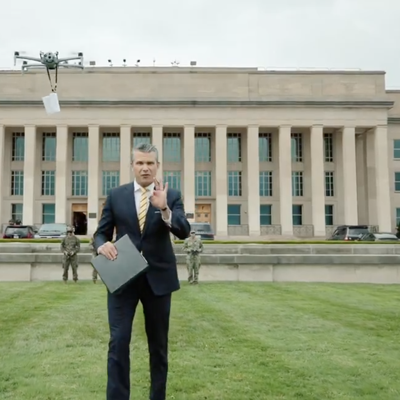When Defense Secretary Pete Hegseth stood on the Pentagon’s parade field last month to announce a memo meant to accelerate the U.S. military’s ability to stock up on cheap drones, the sheet of paper he signed was delivered by a member of the Marine Corps Attack Drone Team, a Quantico, Va.-based unit that just got its start in January.
Since then, the team’s primary work has been to develop the service’s tactics, techniques and procedures for operating armed first-person viewer drones, as infantry units are integrating the use of drones. Their first pamphlet is expected this month, Col. Scott Cuomo, who commands Weapons Training Battalion, Quantico, told reporters in July.
“This is an area where we are not at where we need to be,” he said. “So we need to create an organization to … be the expert on what’s going on on the modern battlefield, specifically in Ukraine.”
The idea for a team came from discussion amongst leadership about the use of drones in Ukraine, Gaza, and the Red Sea over the past few years, he said, and their rising dominance over more complex weapons systems.
The team of 12 is nested under Weapons Training Battalion, Quantico, Cuomo said, in the same spirit of the Marine Corps Shooting Team, where the service’s top marksmen compete. Their job is to experiment with drone technology and operation, then push out best practices to the fleet.
“Once you understand it, all facets of it, make sure that you can train the rest of the Corps to do it,” Cuomo said.
The team started out with radio frequency-capable drones in February, then added fiber-optic drones in July, which are thought to be impervious to jamming technologies that take down drones communicating over radio waves.
They have a range of about 15 miles versus the RF’s handful of miles, Cuomo said, and they’re much cheaper as well. Paired with Sky Node, a command and control software used by the Ukrainians, the drones can lock onto a target and fire on it similar to the way the Javelin shoulder-fired missile system works.
The team is also exploring options outside the ubiquitous quadcopter drone, he said, including what are known as “dropper” drones, which are like self-propelled mortar tubes that can be loaded with a variety of munitions.
“So as we get these capabilities, we’ll work them into the manual, and as you’re seeing in Ukraine, these things change back and forth,” he said.
The MCADT will test their skills this fall at the inaugural U.S. Military Drone Crucible Championship in Florida, hosted by the U.S. National Drone Association.
Then, they’ll travel around the fleet through the winter, holding local competitions for FPV and small unmanned aerial systems operators, first at Quantico, then Okinawa, then Marine Corps Base Hawaii, Camp Pendleton, Calif., and finally Camp Lejeune, N.C.
Top drone operators from those competitions will meet up at Quantico in April for a championship, the winners of which will be invited to join MCADT when it competes in the future.
“Who am I sending to these competitions? I’m sending to the competitions the individuals in each of my squads and sections that are going to be the experts, and they’re going to compete to see who’s the best,” Cuomo said.
Hegseth’s push to ramp up drone procurement is a huge boon to the team, he added, as the Defense Department moves from buying drones at $200,000 apiece to more like $2,000 for small, single-use drones.
“So you’re going to see these capabilities down into our infantry squads, and then you’re also going to see them inside of the new Force Design battalion, inside of the organic precision fires section, within the fires and reconnaissance company, and you will very likely see them inside the scout platoon as well,” he said.
Read the full article here

